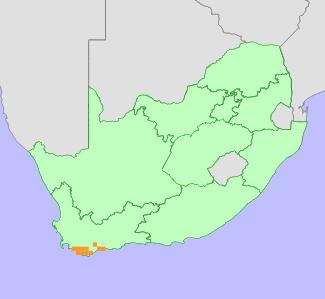|
Scientific Name | Cyrtanthus carneus Lindl. |
Higher Classification | Monocotyledons |
Family | AMARYLLIDACEAE |
Common Names | Sandlelie (a), Sandveldlelie (a) |
National Status |
Status and Criteria | Vulnerable A2c; B1ab(ii,iii,v); C2a(i) |
Assessment Date | 2023/01/15 |
Assessor(s) | D. Raimondo, D.A. Snijman, C. McMaster & N.N. Mhlongo |
Justification | This long-lived bulb species (generation length 30 years) is endemic to the Overberg region and has an area of occupancy (AOO) of 164 km². It occurs in small, severely fragmented subpopulations, and the population is declining due to habitat loss due to agriculture, alien plant invasion, and collection for the horticultural trade. It qualifies as Endangered under criterion B. |
Distribution |
Endemism | South African endemic |
Provincial distribution | Western Cape |
Range | This species is endemic to the Western Cape Province, where it occurs from Kleinmond to Potberg. |
Habitat and Ecology |
Major system | Terrestrial |
Major habitats | Potberg Sandstone Fynbos, Overberg Sandstone Fynbos, Kogelberg Sandstone Fynbos, Albertinia Sand Fynbos, Agulhas Sand Fynbos, Hangklip Sand Fynbos |
Description | It occurs on coastal fynbos on south-facing slopes. |
Threats |
| Habitat loss and fragmentation due to expanding agriculture is a severe past threat, with 34% of its habitat lost since 1940. Many remaining locations are infested with alien invasive plants, but mature individuals appear to be able to persist in spite of heavy infestations. They may, however, fail to recruit. This attractive species is also potentially threatened by the removal of bulbs for the horticultural trade. |
Population |
The population is estimated to consist of fewer than 10 000 individuals, based on data collected by citizen scientists over the past 15 years. Between 100 and 150 subpopulations are inferred based on 93 observations made of this species on the iNaturalist platform. The plants grow as scattered, isolated stands consisting of a few individuals, typically 10 mature individuals or fewer. There is no subpopulation larger than 1000. Based on the calculated loss of suitable habitat since 1940, the population is suspected to have declined by at least 30% over the past three generations (90 years). The population is suspected to still be declining slowly due to ongoing habitat loss and illegal collecting.
|
Population trend | Decreasing |
Conservation |
| This species is conserved in Potberg Nature Reserve (Western Cape Nature Conservation). |
Assessment History |
Taxon assessed |
Status and Criteria |
Citation/Red List version | | Cyrtanthus carneus Lindl. | VU A2c; B1ab(iii,v); C1 | Raimondo et al. (2009) | | Cyrtanthus carneus Lindl. | VU D2 | Victor (2002) | | Cyrtanthus carneus Lindl. | Vulnerable | Hilton-Taylor (1996) | |
Bibliography |
Goldblatt, P. and Manning, J.C. 2000. Cape Plants: A conspectus of the Cape Flora of South Africa. Strelitzia 9. National Botanical Institute, Cape Town.
Hilton-Taylor, C. 1996. Red data list of southern African plants. Strelitzia 4. South African National Botanical Institute, Pretoria.
Raimondo, D., von Staden, L., Foden, W., Victor, J.E., Helme, N.A., Turner, R.C., Kamundi, D.A. and Manyama, P.A. 2009. Red List of South African Plants. Strelitzia 25. South African National Biodiversity Institute, Pretoria.
Reid, C. 1993. Cyrtanthus carneus. Flowering Plants of Africa 52(2):t. 2068.
Reid, C. and Dyer, R.A. 1984. A review of the southern African species of Cyrtanthus. The American Plant Life Society, La Jolla, California.
Victor, J.E. 2002. South Africa. In: J.S. Golding (ed), Southern African plant Red Data Lists. Southern African Botanical Diversity Network Report 14 (pp. 93-120), SABONET, Pretoria.
|
Citation |
| Raimondo, D., Snijman, D.A., McMaster, C. & Mhlongo, N.N. 2023. Cyrtanthus carneus Lindl. National Assessment: Red List of South African Plants version 2024.1. Accessed on 2025/12/23 |
 Comment on this assessment
Comment on this assessment

